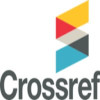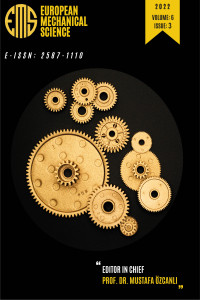Research Article
Aim & Scope
This is an open access journal which means that all content is freely available without charge to the user or his/her institution. Users are allowed to read, download, copy, distribute, print, search, or link to the full texts of the articles in this journal without asking prior permission from the publisher or the author. This is in accordance with the BOAI definition of open access.
No charges are required from the Authors to publish and submission the articles.
All papers will be evaluated by plagiarism detection softwares iThenticate before being sent to the referees.
EMS is a quarterly published journal operating an online submission and peer review system. It allows authors to submit articles online and track their progress via its web interface. The journal aims for a publication speed of 8 weeks from submission until final publication.
This journal is a peer-reviewed open access engineering journal published four times a year.
European Mechanical Science (EMS) is an international, peer reviewed journal which publishes full length original research papers, reviews related to all areas of Mechanical Engineering such as: Solid Mechanics, Materials Engineering, Automotive Engineering, Fluid Mechanics, Thermal Engineering, Engine and Power Engineering, Dynamics & Control, Robotics & Mechatronics, Transportation Engineering, Computational Mechanics, Design, Systems, Manufacturing, BioMedical Engineering; Process Engineering, Aerospace Engineering.
Author Guidelines
All manuscripts must be in English. Pages should be numbered sequentially. The manuscript should be composed in accordance with the Article Template (https://dergipark.org.tr/tr/download/journal-file/17712 ) given above. The maximum length of contributions is 10 pages. For full instructions see the Information for Authors section on the journal’s website:
https://dergipark.org.tr/tr/pub/ems/writing-rules
SUBMISSION
All manuscripts must be submitted electronically via the Internet through the online system for EMS journals at https://dergipark.org.tr/ems . After selecting the journal, you will be guided stepwise through the creation and uploading of the various files. Papers are accepted for evaluation on the understanding that:
• they have not been published,
• they are not being considered for publication simultaneously elsewhere,
• they are not going to be submitted for publication elsewhere
The copyright transfer form, which can be found at
https://dergipark.org.tr/tr/download/journal-file/16273
, must be signed by the corresponding author on behalf of all authors and must accompany all papers submitted.
FORMAT OF THE MANUSCRIPT
The manuscript should be composed in accordance with the Article Template.
The manuscript should be written in the following format:
- A Title that adequately describes the content of the manuscript.
- A list of Authors and their affiliations.
- An Abstract that should not exceed 250 words. The Abstract should state the principal objectives and the scope of the investigation, as well as the methodology employed. It should summarize the results and state the principal conclusions.
- 4-6 significant key words should follow the abstract to aid indexing.
- An Introduction that should provide a review of recent literature and sufficient background information to allow the results of the article to be understood and evaluated.
- A Methods section detailing the theoretical or experimental methods used.
- An Experimental section that should provide details of the experimental set-up and the methods used to obtain the results.
- A Results section that should clearly and concisely present the data, using figures and tables where appropriate.
- A Discussion section that should describe the relationships and generalizations shown by the results and discuss the significance of the results, making comparisons with previously published work. (It may be appropriate to combine the Results and Discussion sections into a single section to improve clarity.)
- A Conclusions section that should present one or more conclusions drawn from the results and subsequent discussion and should not duplicate the Abstract.
- Acknowledgement (optional) of collaboration or preparation assistance may be included. Please note the source of funding for the research.
- References must be cited consecutively in the text using square brackets [1] and collected together in a reference list at the end of the manuscript.
FIGURES
Figures (figures, graphs, illustrations digital images, photographs) must be cited in consecutive numerical order in the text and referred to in both the text and the captions as Figure 1, Figure 2, etc. Figures should be prepared without borders and on white grounding. If a figure is composed of several parts, please mark each part with a), b), c), etc. and provide an explanation for each part in Figure caption. The caption should be self-explanatory. Letters and numbers should be readable.
Graphics (submitted as supplementary files) may be exported in resolution good enough for printing (min. 300 dpi) in any common format, e.g. TIFF, BMP, GIF or JPG, PDF and should be named Fig1.jpg, Fig2.tif, etc. However, graphs and line drawings should be prepared as vector images, e.g. CDR, AI.
Multi-curve graphs should have individual curves marked with a symbol or otherwise provide distinguishing differences using, for example, different thicknesses or dashing.
TABLES
Tables should carry separate titles and must be numbered in consecutive numerical order in the text and referred to in both the text and the captions as Table 1, Table 2, etc. In addition to the physical quantities, such as t (in italics), the units (normal text) should be added in square brackets. Tables should not duplicate data found elsewhere in the manuscript. Tables should be prepared using a table editor and not inserted as a graphic.
RERERENCES
A reference list must be included using the following information as a guide. Only cited text references are to be included. Each reference is to be referred to in the text by a number enclosed in a square bracket (i.e. [3] or [2] to [4] for more references; do not combine more than 3 references, explain each).
References must be numbered and ordered according to where they are first mentioned in the paper, not alphabetically. All references must be complete and accurate. Please add DOI code when available. Examples follow.
MENDELEY FORMAT : https://csl.mendeley.com/styles/12874881/EMS-Jounal-2
Journal Papers:
Surname 1, Initials, Surname 2, Initials (year). Title. Journal, volume, number, pages, DOI code.
[1] Calikoz, R., Ozcanli, B., Serin, F. (2017). Simulating nonlinear materials under vertical forces by using intelligent. European Mechanical Science, 57(7-8): 531-538. doi:10.5545/ems.2017.013.
Journal titles should not be abbreviated. Note that journal title is set in italics.
Books:
Surname 1, Initials, Surname 2, Initials (year). Title. Publisher, place of publication.
[2] Ozgur, M.P. (2012). Fundamentals of Mechanical Engineering. Gunlubey, Ankara.
Chapters in Books:
Surname 1, Initials, Surname 2, Initials (year). Chapter title. Editor(s) of book, book title. Publisher, place of publication, pages.
[3] Akarca, G., Gelidor, M. (2016). Mechanical robotic systems. Calikca, V., Kurbetoglu, A., Merdan, M. (Eds.), Cutting Edge Robotics. Literatur Bergli, Mammendorf, 553-576.
Proceedings Papers:
Surname 1, Initials, Surname 2, Initials (year). Paper title. Proceedings title, pages.
[4] Seferci, N., Malikoglu, S., Tosun, N. (2009). Applied mechanic in process industry. IMSEC 2016 Conference Proceedings, 422-427.
Ethical Principles and Publication Policy
PUBLICATION ETHICS
EUROPEAN MECHANICAL SCIENCE will check for plagiarism for all submitted articles before they are previously published.
If plagiarism content is detected by the editors, the author will be notified to rewrite.
The entire article will be scanned by iThenticate® to prevent plagiarism.
In any case, if more than 20% of the original article submitted is plagiarism, then the article will be rejected and also reported to the author.
We strongly recommend that you check your content before submitting it to EUROPEAN MECHANICAL SCIENCE for publication. Although plagiarism is not completely reliable, it is recommended to use some free plagiarism programs
The publication processes implemented in the EUROPEAN MECHANICAL SCIENCE Journal form the basis for the development and distribution of information in an impartial and respectful manner. The processes implemented in this direction are directly reflected in the quality of the work of the authors and the institutions that support the authors. Peer-reviewed studies are studies that embody and support the scientific method. At this point, it is important that all stakeholders of the process (authors, readers and researchers, publisher, referees and editors) comply with the standards for ethical principles. Within the scope of the publication ethics of the EUROPEAN MECHANICAL SCIENCE Journal, all stakeholders are expected to bear the following ethical responsibilities.
The ethical duties and responsibilities listed below have been prepared as open access, taking into account the guidelines and policies published by the Committee on Publication Ethics (COPE).
Editors of EUROPEAN MECHANICAL SCIENCE Journal should have the following ethical duties and responsibilities based on the "COPE Code of Conduct and Best Practice Guidelines for Journal Editors" and "COPE Best Practice Guidelines for Journal Editors" published by the Committee on Publication Ethics (COPE) as open access :
Yazar Etik Sorumlulukları
1. The works submitted by the author(s) are expected to be original. If the author(s) benefit from or use other works, they are required to cite and/or cite completely and accurately.
2. Persons who do not contribute to the content intellectually in the creation of the work should not be specified as the author.
3. All studies submitted for publication should be explained, if any, that may constitute a conflict of interest, and their relationships.
4. Raw data regarding their articles can be requested from the author(s) within the framework of the evaluation processes; In such a case, the author(s) should be ready to present the expected data and information to the editorial board.
5. The author(s) must have a document showing that they have the right to use the data used and the necessary permissions for the research/analysis.
6. If the author(s) notices an error or mistake regarding his/her published, early appearance or evaluation work, he/she has an obligation to cooperate with the editor in informing, correcting or withdrawing the journal editor or publisher.
7. Authors cannot have their work in the application process of more than one journal at the same time. Each application can be started following the completion of the previous application. A study published in another journal cannot be sent to the EUROPEAN MECHANICAL SCIENCE Journal.
Referee Ethical Responsibilities
1. He should accept to evaluate only studies related to his field of expertise.
2. It should make an evaluation with impartiality and confidentiality.
3. If he thinks that he is facing a conflict of interest during the evaluation process, he should refuse to review the study and inform the journal editor.
4. In accordance with the principle of confidentiality, they should destroy the studies they have examined after the evaluation process. They can only use the final versions of the studies they have reviewed after they are published.
5. Should make the evaluation objectively only in relation to the content of the study. Nationality, gender, religious beliefs, political beliefs and commercial concerns should not be allowed to influence the evaluation.
6. Make the assessment in a constructive and courteous manner. Do not make derogatory personal comments that include hostility, slander and insults.
7. They should perform the work they accept to evaluate on time and with the above ethical responsibilities.
Editors Ethical Responsibilities
1. All publications are judged fairly on the basis of their intellectual content, regardless of the author's gender, race, ethnicity, religion, citizenship and political values.
2. This information about the articles is kept confidential.
3. The observed conflict of interest regarding the article should be disclosed.
4. The Editorial Board is responsible for making publication decisions for submitted articles based on the evaluation of the article, journal editorial board policies and legally prohibited articles against plagiarism, defamation and copyright infringement.
Price Policy
No charges are required from the Authors to publish the articles.
Indexes
Citation Indexes
Other Indexes
Journal Boards
Editor in Chief

Editorial Board
Professional
Iulian Antoniac is Full Professor in Materials Engineering and Biomaterials, Habil in Materials Engineering, Head of Department Metallic Materials Science and Physical Metallurgy, Member of the Senate of the National University of Science and Technology POLITEHNICA Bucharest, Romania. He received his B.Sc., M.Sc., Ph.D., and Postdoc degrees in Materials Science at University POLITEHNICA of Bucharest.
Professor Iulian Antoniac research interests include metallic materials obtaining, characterization and testing; advanced techniques for surface characterization; microscopy techniques; functional materials; biomaterials; bioceramics; coatings; biodegradable metals; biocomposites; implants for orthopedics and dentistry; advanced materials for smart industrial applications; physical and chemical characterization of nano- and micro- particles for biomedical applications.
Professor Iulian Antoniac act as Fellow, Biomaterials Science and Engineering (FBSE), Corresponding Member of the Academy of Romanian Scientist, Past President of the International Society for Ceramics in Medicine (ISCM) and President of the Romanian Society for Biomaterials. He is the author of numerous scientific international papers, publications and proceedings on materials engineering and biomaterials. He is Editor in Chief for the journal Materials Science Forum, editorial board member for other journals and reviewer for more than 50 journals. In 2005, he received the Daniel Bunea Award from the Romanian Society for Biomaterials. Also, he receives many awards for their patents at various international fairs and exhibitions dedicated to patents.

An Associate Professor at the Faculty of Environmental and Mechanical Engineering, Poznan University of Life Sciences, Poland. He has got also some experience while working as assistant professor, visiting professor and researcher at various Polish and foreign universities, e.g.: Poznan University of Technology, Poland; Politecnico di Milano, Italy; Lunds Univeristet, Sweden; Univerza v Ljubljani, Slovenia; Koszalin University of Technology, Poland.
Erdogan Madenci, Ph.D., is a Professor in the Department of Aerospace and Mechanical Engineering at the University of Arizona. With a rich academic background, including a Ph.D. in Engineering Mechanics from UCLA and multiple degrees from Lehigh University, Dr. Madenci has held various esteemed positions such as Visiting Faculty at MIT and Visiting Scientist at NASA. He is a Fellow of ASME, an Associate Fellow of AIAA, and the Editor-in-Chief of the Journal of Peridynamics and Nonlocal Modeling. His research focuses on engineering mechanics, multiphysics simulations, and nonlocal modeling, earning him numerous awards, including the IEEE Electronic Packaging Society's Outstanding Sustained Technical Contribution Award.

Ana Pilipović start to work at University of Zagreb Faculty of Mechanical Engineering and Naval Architecture in the Chair of Polymer Processing, Department of Technology in 2008. and done her doctoral thesis on October 2012., with the topic of the additive manufacturing: Influence of processing parameters on the properties of polymer prototype. From 2008 she is participated in several science international and domestic project like FP7, H2020, IPA, IRI, IRI2, Eco-Innovation, Croatian science foundation and projects from Croatian Ministry of Science and Education. Her special interest lies in additive manufacturing, polymer processing, composite processing, recycling of polymers, mechanical testing of polymers, biopolymers, etc. Up to now she has published as author and co-author 242 scientific and professional papers in journals and conference proceedings in Croatia and abroad. She was a visiting professor at Tecnologico de Monterrey Santiago de Queretaro, San Luis Potosi and Guadalajara, Mexico, Çukurova University Adana, Turkey, Faculty of Mechanical Engineering in Maribor, Slovenia and Faculty of Mechanical Engineering Sarajevo, Bosnia and Herzegovina. She has published chapters in 3 books, mentored 40 master and baccularius theses, 2 rector's award, and is currently mentoring 8 doctorates in the fields of medicine, dentistry and mechanical engineering. In addition to teaching at her home university, she gives lectures at the Polytechnic of Zagreb (Zagreb University of Applied Sciences) and the University of Lyon, France. She won the award "Vera Johanides" for young scientists in 2014 in the field of additive manufacturing awarded by the Croatian Academy of Engineering (HATZ). She is now associate professor and head of Chair of Polymer Processing in University of Zagreb Faculty of Mechanical Engineering and Naval Architecture.
Prof. Dr. Raul Campilho received his Habilitation (Título de Agregado) in Mechanical Engineering from the Faculty of Engineering of the University of Porto in 2020. He completed his Ph.D. in Mechanical Engineering in 2009, his M.Sc. in 2006, and his Graduation in 2003, all from the same institution. He is currently an Assistant Professor at the Instituto Politécnico do Porto, Instituto Superior de Engenharia do Porto.
Prof. Campilho's research interests include material characterization, polymers, composite materials, material joining processes, adhesive joints, finite element method, and fracture mechanics. He also works on advanced manufacturing systems, automation and robotics, industrial design, and underwater robotics.
He has published 320 journal articles, 136 book chapters, and 23 books. Additionally, he has supervised 5 Ph.D. theses and 167 M.Sc. dissertations. His contributions to the field have been recognized with 16 awards. He has also been involved in various national and international research projects.

Nadir Yilmaz is a professor and the department chair of Mechanical Engineering at Howard University, as well as, a licensed professional engineer (P.E.) and consultant. He received B.S., M.S., and Ph.D. degrees in Mechanical Engineering from Istanbul Technical University, Bradley University and New Mexico State University, respectively. He is a Fellow of American Association for the Advancement of Science (AAAS), American Society for Engineering Education (ASEE), American Society of Mechanical Engineers (ASME), National Society of Professional Engineers (NSPE) and Society of Automotive Engineers (SAE International). He has been a noted author of many publications in the fields of combustion, CFD, rocket propulsion and automotive engineering. He was a NASA Academic Mission Services (NAMS) Faculty Researcher, and a U.S. Department of Energy Visiting Faculty at Los Alamos National Laboratory and Sandia National Laboratories. He has educated and mentored many underrepresented minority and female students via various STEM programs including the NSF-funded AMP (Alliance for Minority Participation) program.
Dr. Yilmaz serves as the Editor-In-Chief for the SAE International Journal of Fuels and Lubricants and as a member of the editorial board of numerous international journals. In addition, he serves on SAE Foundation Board of Trustees, NSPE Education Foundation Board of Trustees, New Mexico AMP Advisory Board and the Board of Directors of Society of Automotive Engineers of Turkey. Dr. Yilmaz has also served as the Past Chair of SAE Education Board, NSPE Higher Education Executive Board, ASEE Aerospace Division, SAE Washington DC Section and ASME New Mexico Section. In a Governor-appointed position, Dr. Yilmaz previously served on the New Mexico State Board of Licensure for Professional Engineers and Professional Surveyors.
Technical Editors































